Disclosure: Please note that some links are affiliate links, and at no additional cost to you, we earn a commission if you make a purchase.
If you would like to support this website in some way, using these links will help do exactly that.
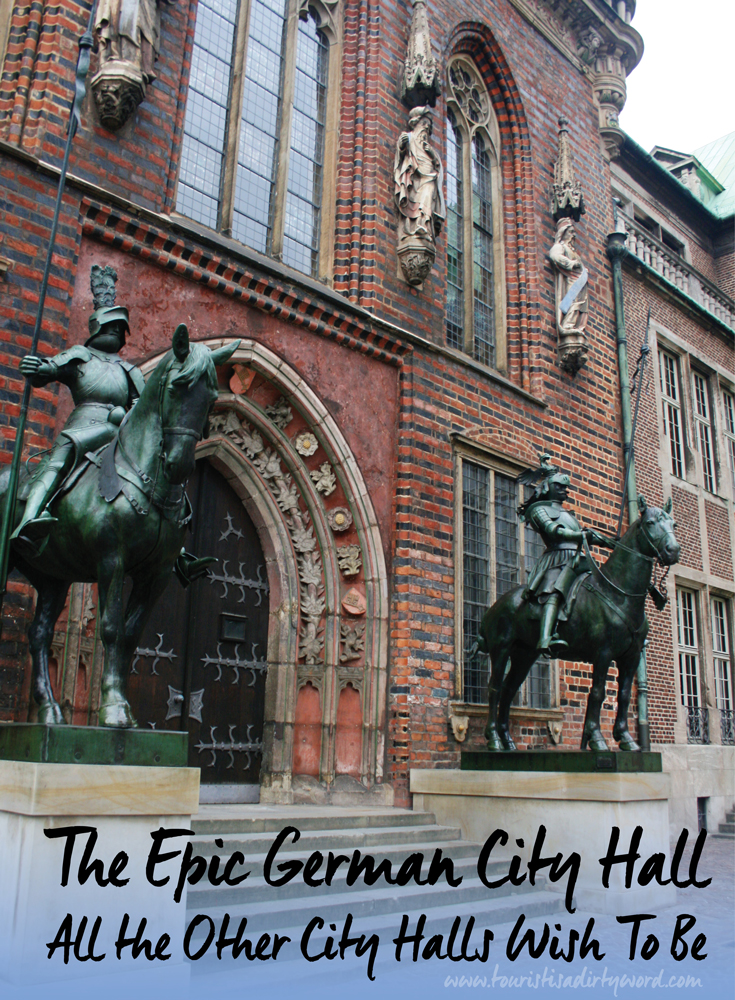
To show the council was serious about its decision to build a new city hall in a new location, in 1404 the Roland Statue was set up. Sebastian will fill you in on Roland and who this austere looking fellow is in the next post. We know the building work began in 1405 and completed sometime after 1410. If you go to the north west facade of the building, it's easy to imagine how the original gothic building looked. This facade with it's pointed windows and octagonal corner turret has survived. This is also where you’ll find Gerhard Marcks Bremen Town Musicians Statue.
In 1594, the city commissioned the windows on the south side to be made larger, and in the process the gothic pointed arches were updated to the trend of the time Renaissance rectangular windows. This change led to the ‘modernization’ of the main facade between 1608 and 1614. They gave the side of the building that faces the market, what was very simple and boxy, a central, predominant focal point in a decorative gable that extends out from the original gothic building with two smaller decorative gables on either side. They changed the windows on this side to the new rectangular style with alternating arch and triangular lintels above. The pointed arched arcade was smoothed out to a rounded arch arcade.
Here's some labeled photos I put together to help illustrate.
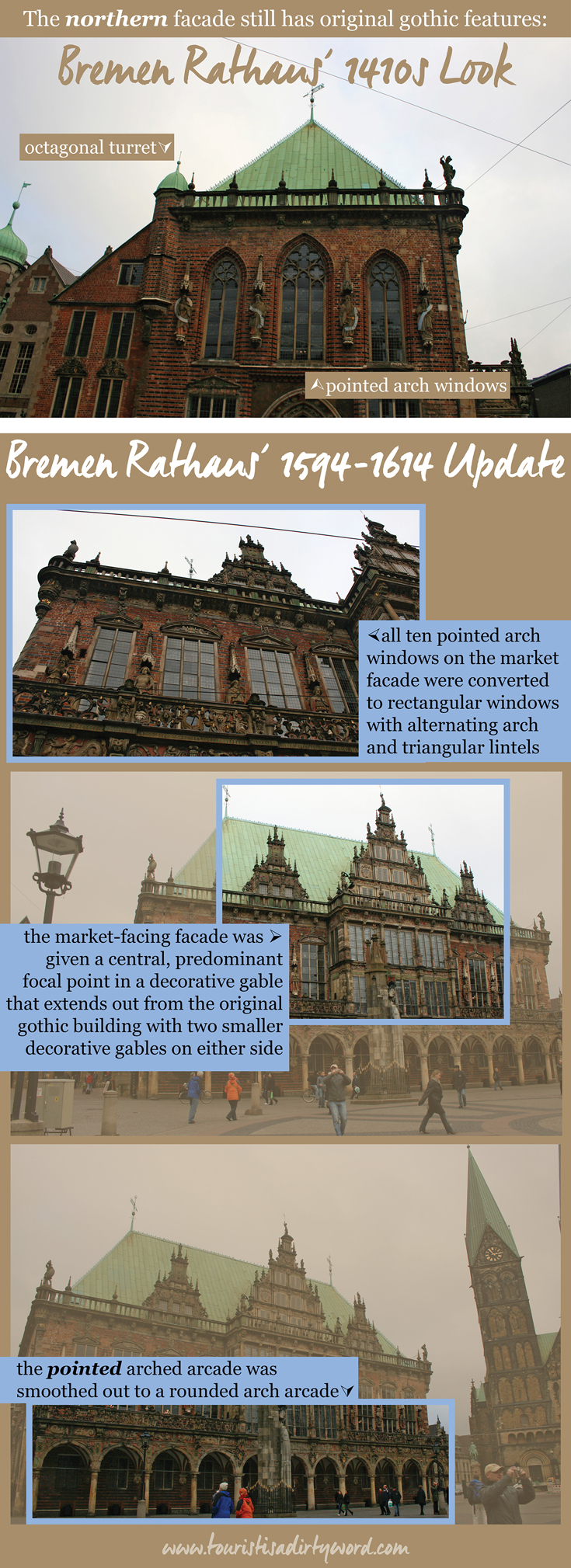
Architecture Overview
We discussed Gothic architecture in an earlier post, Architectural Style Guide to the Neues Rathaus in Munich. With a few minutes of reading, I broke down how to recognize four commonly found architecture styles in Germany. If you missed that post, I strongly encourage you to take a look at this post to get a basic know-how. There’s even photos labeled with key features to look for. To tie that article together neatly with this one, the Neues Rathaus in Munich was built much more recently (1867-1874), in reverence and longing for the time period that the Rathaus in Bremen was built in, 1400-1410 thereabouts. The Rathaus in Bremen is the real deal, what all the town halls wish to be.
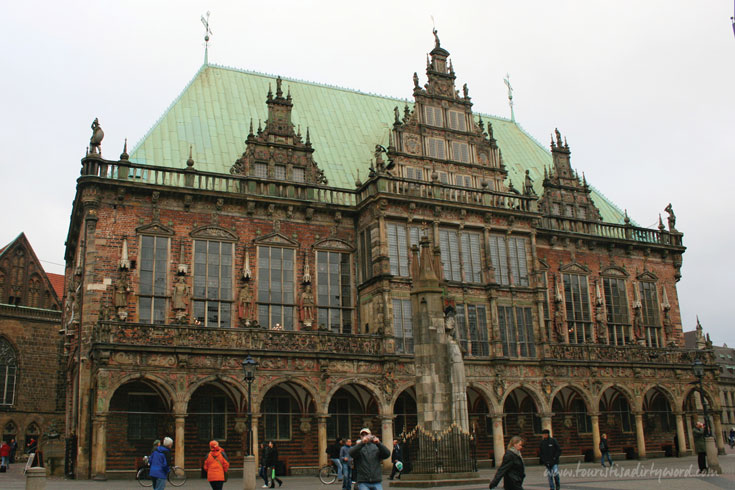
What is UNESCO and Why Does it Matter?
I’ve read about UNESCO World Heritage in the past, and accepted that whatever organization the acronym stood for was important at face value, if nothing else because the acronym is so long, 6 letters. Plus, World Heritage sounds heavily impressive too.
United Nations Educational, Scientific, Cultural Organization
Being a UNESCO World Heritage site means belonging to everyone in the world, regardless of the territories it belongs in. The Rathaus in Bremen and it's Roland Statue as an ensemble has been enfolded into the protection of a world wide organization, and therefore belongs to everyone.
Why was Bremen’s Rathaus & Roland Chosen?
Simply, the Rathaus of Bremen and it's Roland ensemble was chosen as a UNESCO World Heritage site because it's the oldest, most authentic, and continuing example of republican city community during the late medieval European time period.
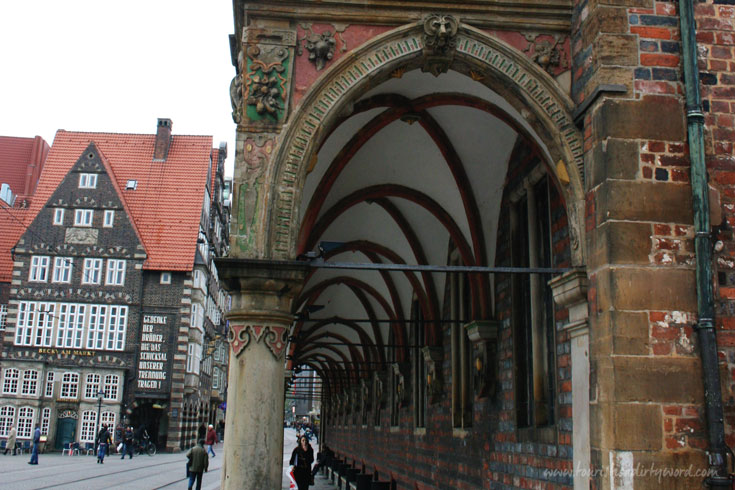
Info on visiting the Town Hall
You can purchase tickets for a guided tour of the Bremen Town Hall online. The one hour long tours run Monday-Saturday at 11am, noon, 3pm, 4pm and Sunday at 11am and noon. However, there are no tours during regional government receptions or events.
We were very unlucky in being in Bremen during a government reception. Do the next best thing, if you can’t get in then go under, literally, under the Town hall to the Ratskeller restaurant and wine cellar. They’re open from 11am until midnight, daily.
Bonus Resources
Read the official UNESCO listing for Bremen Rathaus & Roland.
Watch the UNESCO video about the Bremen in English.
Follow Along
If you enjoyed this article, or these topics sound interesting to you, you'll love our weekly newsletter. You'll receive the newest posts each week and exclusive access to free planning resources like ‘Packing List & Tips for 2 Weeks in Germany’ and ‘Everything You Need to Rent a Car in Germany’.
Thank you for reading!

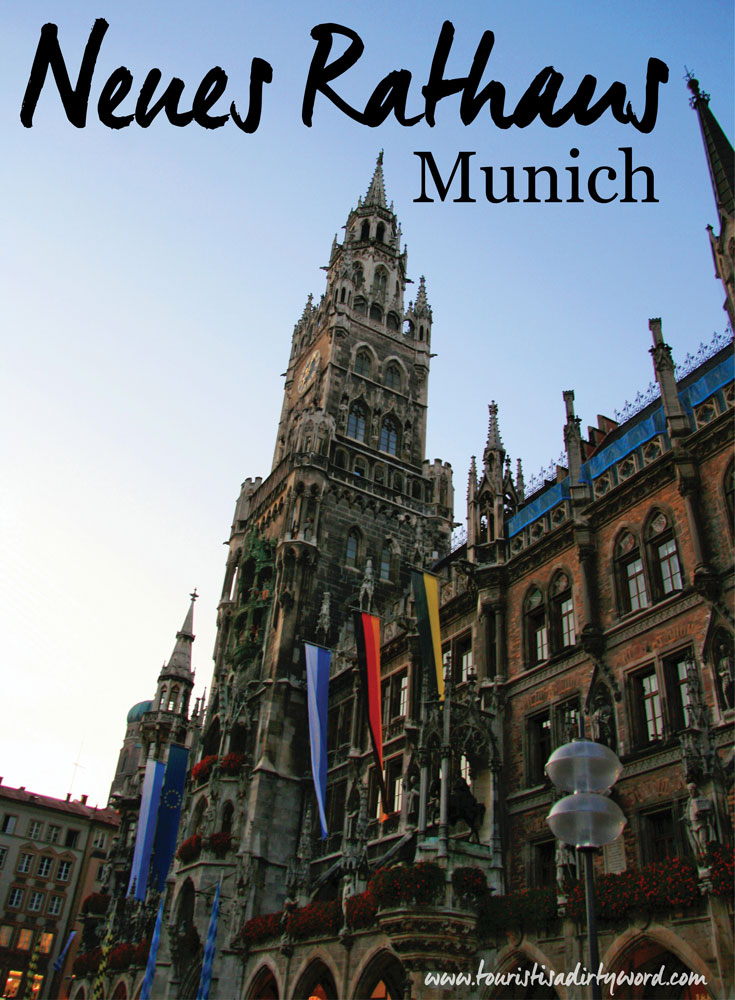
After a full day exploring Oktoberfest, we walked into the old part of Munich. Sensory overloaded from the beautiful costumes and wonderful food of the day, I waddled with my belly full of pretzels, chicken, and beer up this very pointy, church-looking building. The red flowers were shocking amongst the shadowy arcade of windows behind them. When I noticed all of the different flags on the side of the building, I realized it wasn’t a church.
It was the new town hall, Neues Rathaus, where the mayor and city council hold office, and the general headquarters of the Munich city administration. Briefly the memory of our own, gymnasium, institutional-looking city council building back home in Florida shimmers in my mind before dissolving into the beauty before me. It could have been all of the pretzels, but I was confused. Why was this the new town hall, and why did it look so old? And why did it look like a church?
Well, it's complicated, but I’m going to make it super simple..
First, a SUPER basic overview of European architecture (in chronological order) Romanesque to Gothic, to Renaissance, to Gothic Revival.
Romanesque, think sturdy and basic.
Easy way to remember it is the buildings look like sturdy, basic, buildings that could be recreated with preschool wooden building blocks. They got the job done, and didn’t get fancy. [6th century, thereabouts, to late 10th century]
Gothic architects looked at Romanesque buildings and thought, ‘meh, I can do better. Buildings don’t have to be boring.’
Gothic, think skeletal and busy.
Easy way to remember it is the builders wanted to go as high as possible, and let as much light in as possible.
Its easy to go taller if its pointy right? So Gothic has mostly pointy edges.
Want more light? Add more windows. LOTS of windows.
To make the building withstand all the weight now that it's so tall and has tons of windows, it needs more support, but no one wants to LOOK at enormous supporting columns. So they put them outside the building. That’s where the flying buttresses come swooping in to the rescue. Then they didn’t have facebook or instagram to distract them, so they decorated every inch of it. The buildings look visually busy. [12th century in France to 16th century]
Renaissance architects looked at Gothic buildings and thought, ‘Oh my goodness! My eyes are bleeding it’s so busy! Why recreate the wheel, the Greeks and Romans already figured out this stuff, we should just recreate that.’
Renaissance, think columns and geometric.
Easy way to remember it is renaissance sounds like reminisce, as in reminiscing about those old roman/greek glory days.
So here comes the primary school wooden building blocks again. I’ll give them this though, it is a bit more elegant, with a focus on symmetry, decorative columns, and oh-so-pleasing geometric shapes. They cheated a little and used gothic architecture engineering then covered up their tracks with thick, plain walls again. -15th century to 17th century-
Gothic Revival architects looked at Renaissance buildings, then Gothic buildings, then Renaissance buildings again...and thought 'We’re GERMAN. Not Romans, or Greeks! We’re German! We should have German buildings!' I have to mention that Gothic Architecture didn’t actually originate in Germany, it originated in France. Gothic wasn’t POPULAR in France any more! So the Germans thought this was solely their style.
Gothic or Gothic Revival?
The biggest difference between Gothic and Gothic Revival is time, 12th-15th century Gothic, 18th-20th century Gothic Revival. Beyond that, if the stone work looks more uneven, and there are obvious, huge, flying butresses, its likely Gothic. With new building techniques in the 18th-20th century the stones were much smoother and buttresses were not always necessary to support the building's weight.
You just learned how to identify four forms of architecture with a few minutes of reading! Hi-Five! For all my visual learners out there, I took some of my photos of the Munich Neues Rathaus and labeled it with visual clues that its gothic.

Back to the Neues Rathaus in Munich-
Why did the Neues Rathaus in Munich look so old?
Well, although it was built by Georg von Hauberrisser between 1867-1874, which isn’t all that long ago, the popular sentiment at the time believed life was better during medieval times, which had the gothic architecture. This building is part of the Gothic Revival period. They wanted to revive the self-governing glory days of the medieval times and Hanseatic League. It was a close call though. The Munich new town hall was almost Renaissance style. Click here for more about that, and I promise its brief too.
Why did the Neues Rathaus in Munich look like a church?
You know how when there’s a sequel to a movie, usually it's not as memorable as the first one? The first image that pops in my mind when you say Gothic is actually the Notre Dame cathedral in Paris, as well as many other churches. During the 12th and 16th century, when Gothic was born, they only had the time, energy, and motivation to go all out designing churches, and that’s what’s memorable. However, with gothic revival, just like the Neues Rathaus, they started applying that style of design to any type of building, civic buildings included.
Munich simply outgrew their Old Town Hall, which is still standing just around the corner. They even added additional annexes between 1899-1903. For the finishing touch, in 1908 they added a charming glockenspiel to the front facade.
Here are two glockenspiel videos from the Neues Rathaus in Munich, one is for day time, and the other is for night.
Other features worthy of note, there’s over 400 hundred rooms, you can go up to the 255-ft tall observation deck for a fantastic aerial view, and there’s a restaurant dating from 1867 in the basement.
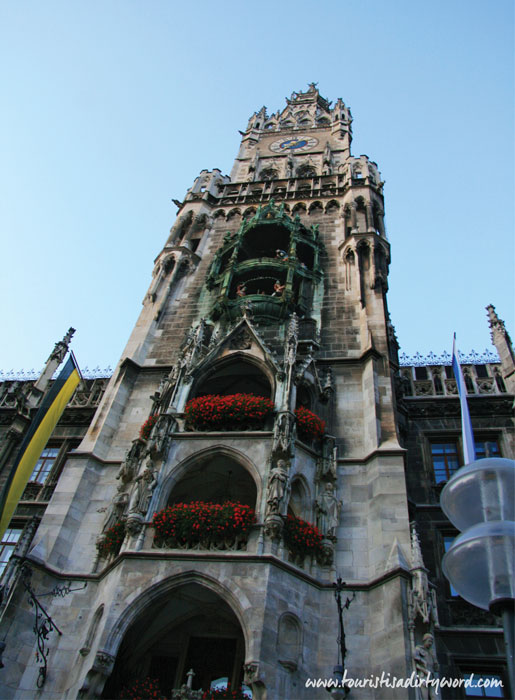
Follow Along
If you enjoyed this article, or these topics sound interesting to you, you'll love our weekly newsletter. You'll receive the newest posts each week and exclusive access to free planning resources like ‘Packing List & Tips for 2 Weeks in Germany’ and ‘Everything You Need to Rent a Car in Germany’.
Thank you for reading!

Bonus Resource: This book, The Gothic Revival by Michael J. Lewis was incredibly helpful in my research on this post about the Neues Rathaus. It's still available for sale on amazon (affiliate link). Chapter 3 was especially insightful on understanding Germany's perspective on the Gothic Revival.
Lewis, Michael J. The Gothic Revival. New York: Thames & Hudson, 2002. Print. Thames & Hudson World of Art.
